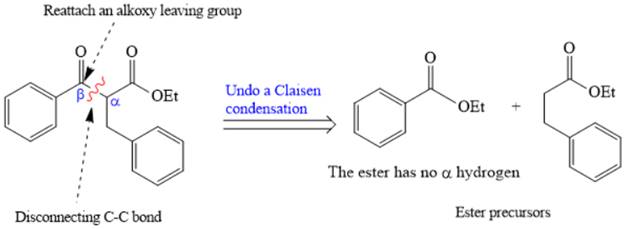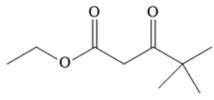
(a)
Interpretation:
The synthesis of given compound using a Claisen condensation is to be shown.
Concept introduction:
In Claisen condensation, ethyl ethanoate (ethyl acetate) is treated with sodium ethoxide, followed by acid work up, a
Answer to Problem 21.67P
The synthesis of given compound is shown below.

Explanation of Solution
The given compound is,

The disconnection of

The Claisen reaction in the forward direction would proceed as follows:

The Claisen and Dieckmann condensations are new
(b)
Interpretation:
The synthesis of given compound using a Claisen condensation is to be shown.
Concept introduction:
In Claisen condensation, ethyl ethanoate (ethyl acetate) is treated with sodium ethoxide, followed by acid work up, a
Answer to Problem 21.67P
The synthesis of given compound is shown below.

Explanation of Solution
The given compound is,

The disconnection of

The Dieckmann reaction in the forward direction would proceed as follows:

The Claisen and Dieckmann condensations are new
(c)
Interpretation:
The synthesis of given compound using a Claisen condensation is to be shown.
Concept introduction:
In Claisen condensation, ethyl ethanoate (ethyl acetate) is treated with sodium ethoxide, followed by acid work up, a
Answer to Problem 21.67P
The synthesis of given compound is shown below.

Explanation of Solution
The given compound is,

The disconnection of

The crossed Claisen reaction in the forward direction would proceed as follows:

The Claisen and Dieckmann condensations are new
(d)
Interpretation:
The synthesis of given compound using a Claisen condensation is to be shown.
Concept introduction:
In Claisen condensation, ethyl ethanoate (ethyl acetate) is treated with sodium ethoxide, followed by acid work up, a
Answer to Problem 21.67P
The synthesis of given compound is shown below.

Explanation of Solution
The given compound is,

The disconnection of

The crossed Claisen reaction in the forward direction would proceed as follows:

The Claisen and Dieckmann condensations are new
Want to see more full solutions like this?
Chapter 21 Solutions
ORGANIC CHEMISTRY E-BOOK W/SMARTWORK5
 ChemistryChemistryISBN:9781305957404Author:Steven S. Zumdahl, Susan A. Zumdahl, Donald J. DeCostePublisher:Cengage Learning
ChemistryChemistryISBN:9781305957404Author:Steven S. Zumdahl, Susan A. Zumdahl, Donald J. DeCostePublisher:Cengage Learning ChemistryChemistryISBN:9781259911156Author:Raymond Chang Dr., Jason Overby ProfessorPublisher:McGraw-Hill Education
ChemistryChemistryISBN:9781259911156Author:Raymond Chang Dr., Jason Overby ProfessorPublisher:McGraw-Hill Education Principles of Instrumental AnalysisChemistryISBN:9781305577213Author:Douglas A. Skoog, F. James Holler, Stanley R. CrouchPublisher:Cengage Learning
Principles of Instrumental AnalysisChemistryISBN:9781305577213Author:Douglas A. Skoog, F. James Holler, Stanley R. CrouchPublisher:Cengage Learning Organic ChemistryChemistryISBN:9780078021558Author:Janice Gorzynski Smith Dr.Publisher:McGraw-Hill Education
Organic ChemistryChemistryISBN:9780078021558Author:Janice Gorzynski Smith Dr.Publisher:McGraw-Hill Education Chemistry: Principles and ReactionsChemistryISBN:9781305079373Author:William L. Masterton, Cecile N. HurleyPublisher:Cengage Learning
Chemistry: Principles and ReactionsChemistryISBN:9781305079373Author:William L. Masterton, Cecile N. HurleyPublisher:Cengage Learning Elementary Principles of Chemical Processes, Bind...ChemistryISBN:9781118431221Author:Richard M. Felder, Ronald W. Rousseau, Lisa G. BullardPublisher:WILEY
Elementary Principles of Chemical Processes, Bind...ChemistryISBN:9781118431221Author:Richard M. Felder, Ronald W. Rousseau, Lisa G. BullardPublisher:WILEY





